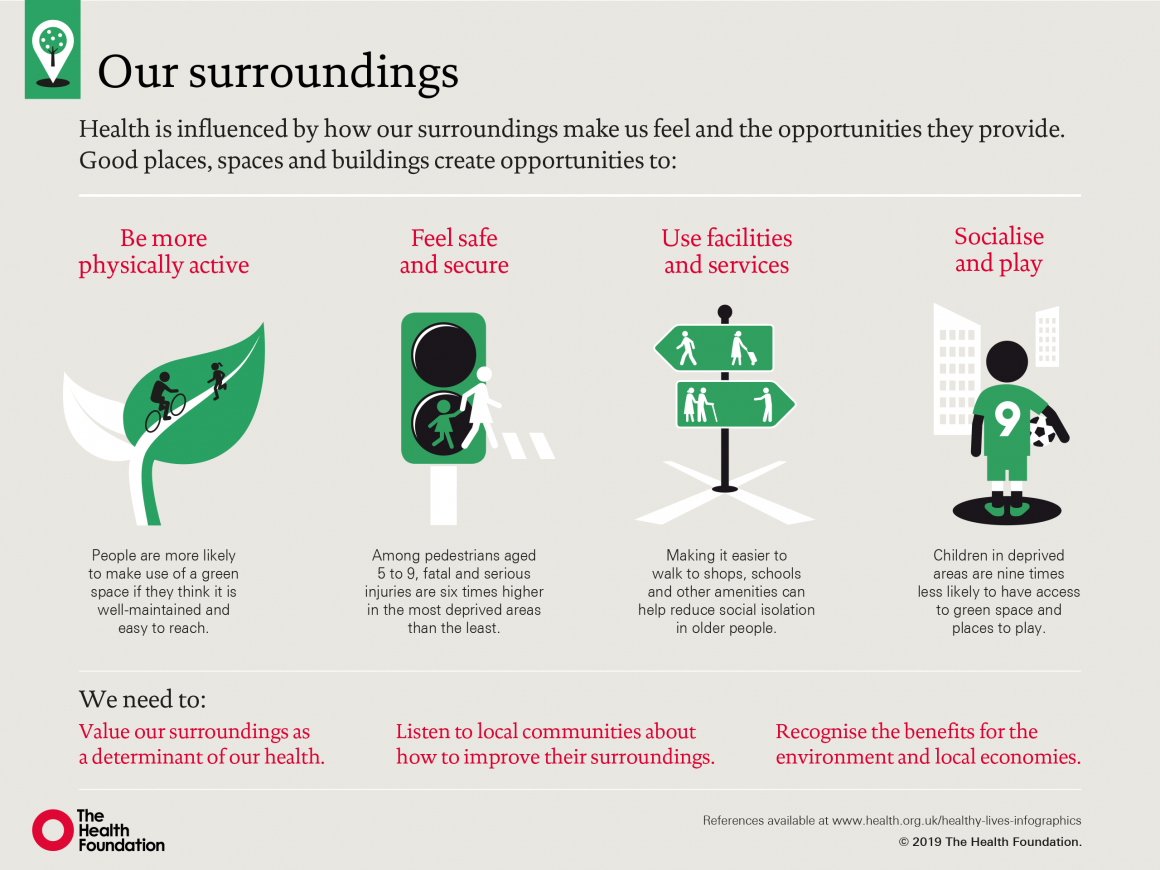How do our surroundings influence our health?
31 July 2017

In June 2017, we released an infographic looking at the ‘bigger picture’ of what makes us healthy. It identified eight factors, outside of health care, that influence people’s opportunity to live a healthy life.
One of these factors is our surroundings – this month’s infographic (shown below) looks at how health is influenced by how places, spaces and buildings make us feel, and the opportunities they provide.
We want our series of infographics to be a useful resource to help change the conversation about what makes us healthy. You are welcome to download, save and share them for education and non-commercial use. Please make sure that no modifications are made and that the Health Foundation and the source is clearly acknowledged in full.
If you have any further questions about using our resources in your work please get in touch at website@health.org.uk
A few observations from a recent train journey from London to Swansea and an interesting development in Welsh legislation may help to bring our latest infographic to life. The last twenty minutes of this train route takes you from Port Talbot to Swansea – from the UK’s largest steelworks, through green space and smaller towns and suburbs, to the centre of Wales’ second largest city. As with similar stretches across the UK, the environments in which people live, work and play can change significantly over a matter of metres or miles.
These changes in geography are often accompanied by significant changes in the length of time people are likely to live in good health: the healthy life expectancy gap between the most and least deprived parts of the UK is 19 years. In part, this gap often results from differences in the opportunities provided by people’s local environment. Our new infographic illustrates how good surroundings can enable people to:
- be more physically active
- feel safe and secure
- use facilities and services
- socialise and play
While this list isn’t exhaustive, it highlights some important examples of the benefits of good surroundings.
Inequalities
Our infographic also reveals some significant inequalities in access to these opportunities. Children in deprived areas are nine times less likely to have access to places to play, and people who live near poorly maintained green space are understandably less likely to use it.
So what does this mean for health? To give just one example, a study in the Lancet in July 2017 identified nine key risk factors for dementia. Among them were social isolation, physical inactivity and associated diseases such as type 2 diabetes. These factors can be prevented through taking action on aspects of our wider environment. From allotments to football pitches, some of the facilities and spaces dotted along my train route are perfect examples of how our surroundings can create opportunities for people to socialise and be physically active.
We want every person in the UK to have access to the opportunities to live a healthy life. For this to happen, change is required in how we think about and act on the relationship between our surroundings and health.
In this infographic, we identify three important steps.
- There needs to be a fundamental shift in how we perceive improvements in our surroundings – not as an added extra but as a key determinant of our health. An example of this in action is the new Public Health (Wales) Act. This requires prospective policies to go through a Health Impact Assessment to foresee the likely impact on health. This means that planning decisions that affect people’s surroundings may become inextricably linked to health.
- There needs to be greater recognition of how improving surroundings can also help protect the environment and support local economies, which in turn impact on health. For example, design features such as seating, greenery and restricting traffic can increase retail footfall by around 30%.
- Finally, the views and knowledge of local communities are vital in creating environments that offer the opportunities that people want and need.
Underlying these necessary changes is an important point about how we understand and talk about health more generally. Once off the train, a taxi driver asked me what I did for a living. I told him that I worked for a health charity. He laughed and said ‘not a sick charity then’. He was spot on. To improve the health of the UK population, we need to look beyond ill health, to determinants like our surroundings that can create good health.
References
- People are more likely to make use of green space if they think it is well-maintained and easy to reach
Health Scotland. Place and communities. 2017. Available from: http://www.healthscotland.scot/media/1088/27414-place-and-communties-06-16.pdf and Balfour R, Allen J. Local Action on Health Inequalities: Improving Access to Green Spaces. Health Equity Evidence Review 8. 2014. Available from: https://www.gov.uk/government/uploads/system/uploads/attachment_data/file/357411/Review8_Green_spaces_health_inequalities.pdf
- Among pedestrians aged 5 to 9, fatal and serious injuries are six times higher in the most deprived areas than the least
Public Health England, Reducing unintentional injuries on the roads among children and young people under 25 years. London: Public Health England; 2018. Available from: https://assets.publishing.service.gov.uk/government/uploads/system/uploads/attachment_data/file/695781/Reducing_unintentional_injuries_on_the_roads_among_children_and_young_people_.pdf
- Making it easier to walk to shops, schools and other amenities can help reduce isolation in older people
Public Health England, Spatial Planning for Health: An evidence resource for planning and designing healthier places. London: Public Health England; 2017. Available from: https://www.gov.uk/government/uploads/system/uploads/attachment_data/file/625568/Spatial_planning_for_health_an_evidence_resource.pdf
based on Beard & Petitot, 2010; McCormack & Sheill, 2011.
- Children in deprived areas are nine times less likely to have access to green space and places to play
National Children’s Bureau . Greater Expectations: raising aspirations for our children. London: National Children’s Bureau; 2013. Available from:
https://www.ncb.org.uk/sites/default/files/uploads/documents/Policy_docs/GEXP_final%20WEB.pdf
Related blogs
Work with us
We look for talented and passionate individuals as everyone at the Health Foundation has an important role to play.
View current vacanciesThe Q community
Q is an initiative connecting people with improvement expertise across the UK.
Find out more


